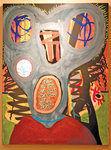If one could see sounds, what would that look like? Probably a painting by Milo Redwood.
“They are silent songs,” said Redwood during an interview in his paint studio on Water Street in Port Townsend. “Honestly it sounds weird, but I think they are mostly musical.”
This item is available in full to subscribers.
We have recently launched a new and improved website. To continue reading, you will need to either log into your subscriber account, or purchase a new subscription.
If you had an active account on our previous website, then you have an account here. Simply reset your password to regain access to your account.
If you did not have an account on our previous website, but are a current print subscriber, click here to set up your website account.
Otherwise, click here to view your options for subscribing.
* Having trouble? Call our circulation department at 360-385-2900, or email our support.
Please log in to continue |
|



If one could see sounds, what would that look like? Probably a painting by Milo Redwood.
“They are silent songs,” said Redwood during an interview in his paint studio on Water Street in Port Townsend. “Honestly it sounds weird, but I think they are mostly musical.”
Redwood, 58, whose birth name was Roger Neal Hager, is a prolific painter in the contemporary art form whose paintings have begun to attract the attention of stars in the music industry, in no small part because of his partnership with Wyeth “B” Barclay.
B spent years as a performer and producer in the record industry, spending over a decade working with hip hop group Bone Thugs-N-Harmony.
“I have been around art my whole life, but I was in the music industry,” Barclay said. “I didn’t care about that world, the visual arts or the wall arts.”
That all changed when Barclay heard tell of Redwood while sipping java at Better Living Through Coffee. Eventually, B made his way into Milo’s studio.
“It was like walking into Pablo Picasso’s studio before Picasso was Picasso.”
B knew he had stumbled on something special, and was taking the first steps onto the road of the next great adventure in his life.
“Every time I have had that feeling I have embarked on the journey, but this one was in the visual arts,” he said. “From the moment me and Milo sat down, we had days and days of wonderful philosophical conversations about life, about liberation, about beauty about joy.”
Also about women, Milo interjected.
“The honesty behind who he was just absolutely oozed,” B said. “That honesty, you just don’t see a lot of anymore. When you see that honesty, you want to elevate that honesty.”
B was convinced he needed to share Milo with his contemporaries in the music industry and the world at large.
“In Port Townsend, Washington, there is a beautiful soul staying true to his being; creating beauty that is going to enhance the value of your life.”
A mix of old and new schools
Born in the years separating the Baby Boomer generation from Gen-X, Redwood is not intrinsically hardwired for the modern hyperconnected world of social media.
“Milo doesn’t even email,” B said.
“I have never texted in my life,” Redwood added. “I don’t know how.”
If B needs to get into contact with Redwood, he must rely on somewhat outdated technology.
“I have to call him on a landline and leave a message,” B said incredulously. “He actually returns messages from a message machine, which is great.”
Since B is a millennial, and has many years of experience in the music industry, he knows how to network and build hype.
With B as his manager, Redwood is able to focus on his art.
“Don’t worry about the destination,” B told Milo. “Create. I got the destination. You just keep doing what you do.”
‘Freedoming’
Before becoming a full-time artist, Redwood bounced around from job to job, living an average white collar life.
“I was a realtor. I worked a desk in a bank. I made decent money on and off, but I was living someone else’s life. It wasn’t my life.”
Being in the 9 to 5 rat race just wasn’t fulfilling Redwood on an intrinsic level, he said.
Then, in 1996, Redwood landed in Port Townsend. Roger Neal Hager became Milo Redwood. It was a breakthrough, a new beginning, he said.
“It was a rebirth. I managed to become free from the chains I myself had invented and put on myself. Because I am a hard-headed man, I had to try them and let them burn up.”
That acceptance of freedom was just the beginning, Redwood said.
“It continues. Life is a verb. Freedom is a verb. It is hard to explain. I am freedoming.”
That life philosophy is embedded in Redwood’s latest project, “Windows of Liberation.”
“I look at life itself as flow,” Redwood said. “Every time your heart beats, you are different. This is a classic Heraclides line; ‘you don’t step in the same river twice.’”
With that in mind, no two paintings can ever be the same because the Redwood creating the art is himself not the same from moment to moment.
“I don’t have a typical piece,” he said. “They are so different. One is six months and it still is not finished whereas this I started last night, and it could be finished today.”
Redwood paints near continuously, always in seclusion. His body of work continues to grow exponentially.
The only constant in his work is the presence of music, he said, both auditorily and theoretically.
“I can’t really explain it but it has something to do with clarity, energy receptivity,” Redwood said. “It gets to be musical. If you are in a band or have been in a band, that feeling of timelessness when you are in the zone, that’s it. If I am in the zone, that has a lot to do with how the painting comes through. The more pure the zone, the faster the painting.”
There is a ritual for the process, although none have seen it save Redwood.
Over the last year, part of that ritual has been listening to Bebop jazz from the late 1930s through the mid-1940s. The selection of that period is not by accident as it happened before the first atomic bomb was dropped in anger on Aug. 6, 1945.
“I happen to think after the bomb, everything changed,” Redwood said. “Music, art and literature for sure.”
However, Redwood has been bitten by post-atomic New Wave of late.
“In the last week it has been Talking Heads,” he said. “I just got two CDs in the mail yesterday. I am the only one buying CDs in the world right now.”
Whatever he is listening to, the energy of the music as transmitted through his paintings is attracting attention.
Musical feeling
“It is really interesting because the collectors, the young demographic collecting Milos, and musicians and entertainers buying Milos, it does have a musical feeling,” B said. “It speaks to them and they gravitate towards them.”
B said he has witnessed the eyes of musicians light up when they view a painting by Redwood.
“You can tell when you go in front of a musician and they look at a Milo, they see their passion in a whole different form. They create their passion through music but they can see it now. It is beautiful how much that resonates, how much it is a pure conduit, becoming imbued into the pieces.”
That vibe is replete with the sense of artistic freedom, B said, especially in the “Windows of Liberation” series.
“They are like a window that you hang on your wall. You look and that liberty just frees you.”
When asked how he would explain his paintings to a person if they were blind, Milo said he would tell them to feel it.
“I am totally against that,” B said with a hearty laugh. “No touching the painting. I am very protective of these paintings.”
Instead, B said he would just play a record for the person and that would be enough.
Still, the paintings have wonderful textures, B said.
“If someone was blind and felt the painting, I do believe they would get a wonderful sense of the painting.”